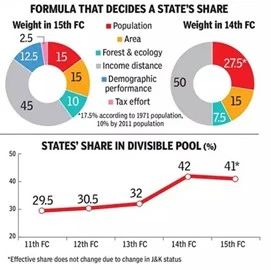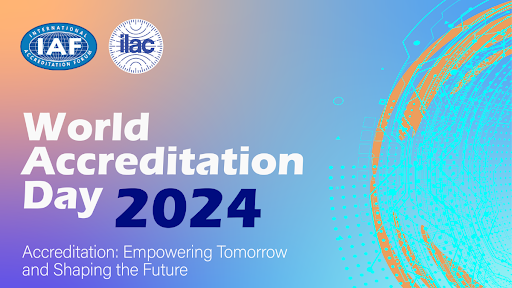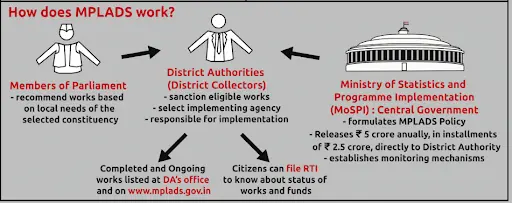Saturday, 15th June 2024
China’s ‘grey-zone’ warfare tactics against Taiwan
Why in the news?
- Recently, President Lai Ching-te assumed office in Taiwan, China has responded strongly to his pro-independence statements by employing sophisticated tactics against his Democratic Progressive Party.

Background of the China-Taiwan Issue:
- Origins: The conflict traces back to the Chinese Civil War (1927-1950). After the Communist victory in 1949, the Nationalist government retreated to Taiwan, establishing the Republic of China (ROC), while the Communists declared the People’s Republic of China (PRC) on the mainland.
- Claims and Dispute: China views Taiwan as a breakaway province to be reunified with the mainland, whereas Taiwan sees itself as a distinct, democratic entity. This disagreement over Taiwan’s political status fuels ongoing tensions.
- Strategic Importance: Taiwan's significance lies in its location within the “first island chain” in the western Pacific and its dominance in the global semiconductor industry. Control over Taiwan would boost China’s regional power and potentially threaten US interests, while Taiwan’s independence is crucial for the US and its allies.
What is Grey Zone Warfare?
- About:
- Grey Zone Warfare refers to coercive measures used to exploit the space between peace and war, deliberately staying below the threshold that would provoke a conventional military response.
- Origin:
- Emerging from the Cold War era post-1945, the development of nuclear weapons necessitated restraint in direct conflicts, as the cost and risk of escalation became too high.
- Methods: Grey Zone Warfare includes both kinetic and non-kinetic methods employed by conventional military forces and irregular proxies.
- Kinetic Methods: Use of proxies for on-ground action or changing the territorial status quo through coercion or militarization.
- Example: China's actions in the South China Sea and Russia's invasion of Crimea.
- Non-Kinetic Methods: Activities range from nefarious economic activities, influence operations, and cyberattacks to mercenary operations, assassinations, disinformation campaigns, economic actions like debt traps and sanctions, and election meddling.
- Kinetic Methods: Use of proxies for on-ground action or changing the territorial status quo through coercion or militarization.
- Prime Objectives:
- Escalation Bait: Small actions designed to provoke the other party to escalate, allowing the aggressor to respond in kind, legitimised as self-defence.
- Projection of Strength: Countries display their capabilities and aim to normalise disputed territorial claims by consistently marking a presence in those regions.
What are the elements of Grey-Zone Warfare ?
- Military Pressure: The People's Liberation Army Eastern Theater Command (PLA ETC) regularly conducts training drills and simulated invasion scenarios, including 3D animation videos of missile attacks on Taiwan, to intimidate and exert psychological pressure.
- Grey-Zone Warfare: The PLA carries out continuous sorties of fighter jets, UAVs, and strategic fighters over and around Taiwan, aiming to wear down Taiwan's defence forces through sustained pressure and intelligence gathering.
- Economic Coercion: China suspended preferential tax rates for 134 chemical imports from Taiwan under the Economic Cooperation Framework Agreement (ECFA) in response to pro-independence statements by Taiwan's President Lai Ching-te and Taipei's restrictions on over 2,000 Chinese imports.
What are China's Grey Zone Tactics Against India ?
- Cyber Operations:
- China targets India's critical infrastructure and political systems through cyber operations like hacking, data theft, denial of service attacks, and disinformation.
- In 2022, India's power transmission systems faced numerous cyber-attacks reportedly linked to Chinese sources.
- Information Warfare:
- China employs propaganda, rumour-spreading, and social media manipulation to create societal divisions and undermine trust within India.
- For instance, threatening messages to North Eastern Indian communities in Bengaluru were traced back to China, revealing a campaign to influence internal affairs.
- Support to Proxy Forces:
- China supports insurgent groups and non-state actors within India to create discord and deplete resources.
- This strategy, evident in the 1980s and 1990s with Chinese backing of northeast insurgent movements, reportedly continues today.
- Economic Coercion:
- China uses economic coercion by imposing trade restrictions and leveraging economic influence to pressure India.
- The Belt and Road Initiative showcases how China could use economic leverage for political and strategic gains.
- Legal and Diplomatic Manoeuvring:
- China exploits legal loopholes, leverages international institutions, and manipulates alliances to undermine India’s international standing.
- For example, China uses civilian fishing fleets to assert presence in the South China Sea, circumventing international legal challenges.
- Military Intimidation:
- China engages in military intimidation by massing troops near borders or in contested regions to suggest potential escalation.
- A significant instance is the deployment of People’s Liberation Army (PLA) troops in the contested Galwan region in Ladakh.
India’s Counter Measures to Grey-Zone Warfare:
- Enhancing Border Defense:
- The deployment of advanced surveillance systems, including UAVs (Unmanned Aerial Vehicles) and high-tech surveillance cameras, aids in monitoring and responding to adversarial movements.
- Strengthening Strategic Partnerships:
- India is enhancing its strategic position through defence collaborations with allies. Notable agreements include:
- LEMOA (Logistics Exchange Memorandum of Agreement): Facilitates logistical support between Indian and US militaries.
- COMCASA (Communications Compatibility and Security Agreement): Ensures secure communications between the two forces.
- BECA (Basic Exchange and Cooperation Agreement): Allows sharing of geospatial intelligence.
- Participating in Joint Military Exercises:
- Exercise Malabar: Initially bilateral between India and the US, now includes Japan and Australia, focusing on naval interoperability.
- Indo-Russian Exercise Indra: A bi-annual exercise involving Army, Navy, and Air Force to boost cooperation with Russia.
- Expanding Naval Cooperation:
- Mission SAGAR (Security and Growth for All in the Region): Ensures maritime security and stability in the Indian Ocean Region (IOR) by providing humanitarian assistance and disaster relief.
- Indian Ocean Naval Symposium (IONS): A forum led by India to increase cooperation among IOR navies and address regional security challenges.
- Advancing Defence Technology Collaborations:
- India is co-developing and co-producing defence technology with international partners. The Quad Alliance, including the US, Australia, and Japan, exemplifies this effort to address regional security through technological collaboration.
- Enhancing Information Sharing:
- Information Fusion Centre – Indian Ocean Region (IFC-IOR): Enhances maritime security by serving as a hub for real-time information sharing among IOR countries, improving regional maritime domain awareness.
- Modernising Armed Forces:
- India is investing in modernising its military through new technology and indigenous defence production, focusing on reducing dependency on foreign imports. Initiatives include:
- Make in India: Promotes domestic defence production.
- Tejas Light Combat Aircraft (LCA): Developed indigenously.
- Advanced Towed Artillery Gun System (ATAGS): Enhances artillery capabilities.
- Akash Surface-to-Air Missile System: Strengthens air defence
- India is investing in modernising its military through new technology and indigenous defence production, focusing on reducing dependency on foreign imports. Initiatives include:
Conclusion:
Taiwan must navigate China’s multifaceted 'grey-zone' tactics through resilience in defence, strategic alliances, and international advocacy to safeguard its sovereignty and democratic identity amid escalating pressures. By promoting international awareness and cooperation, Taiwan can counteract China's coercive strategies and maintain its democratic integrity in the face of growing challenges.
|
UPSC Civil Services Examination, Previous Year Questions (PYQs) Mains: Q:1 South China Sea has assumed great geopolitical significance in the present context. Comment. (2016) |
Source: TH
Gig Economy and Platform Workers in India
Why in the news?
- Recently, gig workers have raised concerns about incidents of heat stroke and fainting, exacerbated by the lack of health support from the companies employing them.
- As per a report published by Nasscom, the Indian gig workforce is expected to expand to 23.5 Mn workers by FY30 from 7.7 Mn in FY2.
- Gig workers will form 4.1% of the total workforce in India by FY30, from 1.5% in FY21 and approximately 22% of the jobs are high-skilled, 47% are medium-skilled, and ~31% are low-skilled.

Who are Gig Workers?
- Gig workers are individuals engaged in temporary, flexible work arrangements, often serving multiple clients or companies, performing tasks or providing services.
- They are typically independent contractors rather than traditional employees, giving them more control over when, where, and how they work.
Gig Economy:
- The gig economy, also known as the freelance or on-demand economy, is gaining prominence in India. It is marked by temporary and flexible job arrangements.
- Companies are increasingly opting to hire short-term contractors, consultants, and freelancers instead of committing to full-time employees.
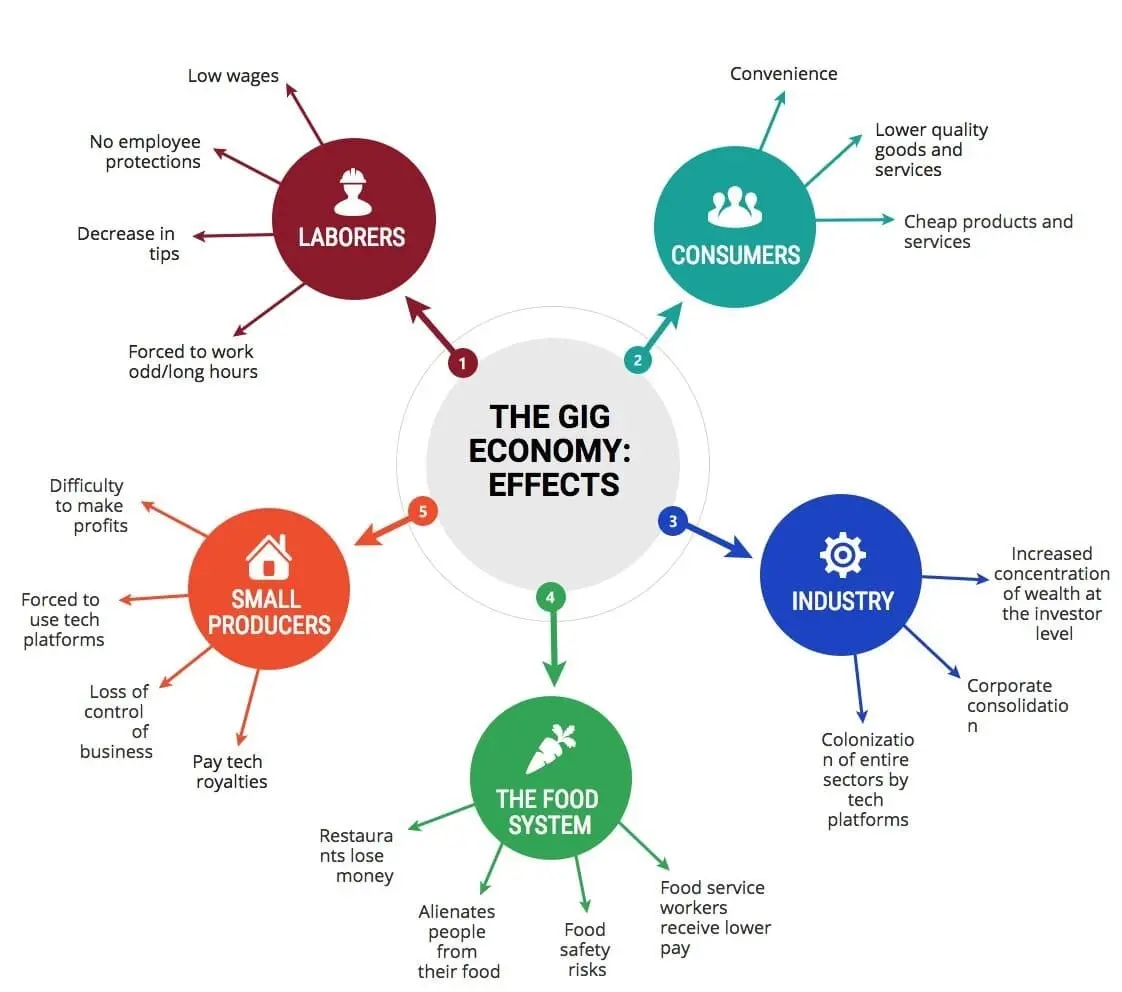
Growth of the Gig Economy:
- In 2020-21, the gig economy in India employed 77 lakh workers, accounting for 2.6% of the non-agricultural workforce and 1.5% of the total workforce, according to a NITI Aayog report.
- Approximately 47% are engaged in medium-skilled jobs, 22% in high-skilled jobs, and 31% in low-skilled jobs within the gig economy.
- By 2029-30, the gig economy is projected to grow significantly, reaching 2.35 crore workers. At that point, gig workers are expected to constitute 6.7% of the non-agricultural workforce and 4.1% of the total workforce in India.
Why is it Essential to Provide Social Security Benefits to Gig Workers?
- Economic Security:
- The gig economy's reliance on demand-driven work lacks job security, necessitating social security benefits like unemployment insurance, disability coverage, and retirement savings to ensure stable income.
- More Productive Workforce:
- Lack of access to employer-sponsored health insurance makes gig workers vulnerable to unexpected medical expenses.
- Prioritising their health through social security benefits can foster a healthier and more productive workforce.
- Equity in Opportunities:
- Exemption from traditional employment protections exposes gig workers to exploitative conditions and inadequate compensation.
- Social security benefits can help mitigate these disparities and ensure fair treatment.
- Long-term Financial Security:
- Without employer-sponsored retirement plans, gig workers often struggle to save for retirement, increasing their risk of financial hardship later in life.
- Social security benefits enable them to save effectively and reduce dependence on public assistance.
Challenges Faced by Gig Workers:
- Long Working Hours:
- Nearly 30% of app-based cab drivers work over 14 hours daily; more than 83% work more than 10 hours, with 60% exceeding 12 hours.
- About 60% of drivers from Scheduled Castes (SC) and Scheduled Tribes (ST) work over 14 hours daily.
- Low Pay:
- Over 43% of gig workers earn less than Rs 500 daily (Rs 15,000 monthly after deductions).
- 34% of app-based delivery persons earn less than Rs 10,000 monthly, contributing to income disparities.
- Financial Strain:
- 72% of cab drivers and 76% of delivery persons face difficulties managing expenses.
- 68% of cab drivers' total expenses exceed their earnings, leading to potential debt situations.
- Unsatisfactory Compensation:
- More than 80% of app-based cab drivers and over 73% of delivery persons are dissatisfied with their earnings.
- Companies deducting 31-40% of the commission rate per ride exacerbates dissatisfaction.
- Work Conditions:
- Extensive work hours lead to physical exhaustion and increase the risk of road accidents, exacerbated by demanding delivery policies.
- Limited union membership (less than 37% of drivers) affects their ability to negotiate better conditions.
- Issues with Platforms:
- Workers face challenges such as ID deactivation and customer misconduct, which hinder their work effectiveness.
- A majority report negative impacts from customer behaviour, affecting job satisfaction and performance.
What are the Government Initiatives?
- National Urban Policy Framework (NUPF): Recognizes urbanisation in India, aiming to manage growth as cities expand to 558.8 million by 2031. Cities and towns are pivotal in India’s economic development.
- The Code on Wages, 2019: This code mandates a universal minimum wage and floor wage applicable across both organised and unorganised sectors, thereby extending coverage to gig workers as well.
- Code of Social Security (2020): Proposes social security schemes for gig and platform workers, covering life and disability, accident insurance, health, maternity benefits, and old age protection. Yet to be implemented.
- e-Shram Portal: Launched for registering unorganised workers, including gig and platform workers, across 400 occupations. Self-declaration basis for registration.
- Registration and Welfare Bill (2023): Introduced to regulate gig platforms, with provisions to penalise aggregators for misconduct. Aims to ensure welfare and rights protection for gig workers in Rajasthan.
Recommendations for the Future:
- Platform-Led Skilling Initiatives: Platforms should lead outcome-based skilling with educational and vocational partnerships to bridge worker skill gaps. Continuous assessments and certifications ensure relevance in a dynamic market.
- Enhanced Social Inclusion: Platforms should create supportive environments for women and persons with disabilities, implementing policies to mitigate biases and ensure equitable access.
- Extension of Social Security Measures: This includes provisions like paid sick leave, healthcare access, insurance, and retirement plans. Platforms should collaborate with government and insurers for effective implementation.
- Transparency in Data Sharing: Platforms must uphold transparency in data practices while safeguarding user privacy, enabling stakeholders to analyse trends, identify challenges, and tailor interventions.
Conclusion:
Thus, improving the conditions of workers in the gig economy requires comprehensive measures. By implementing fair regulatory frameworks, enhancing social security provisions, and fostering collaboration among stakeholders, we can create a more equitable and sustainable environment for gig workers in India. These efforts are essential to uphold dignity and fairness in the evolving landscape of work.
|
UPSC Civil Services Examination, Previous Year Question (PYQ) Mains Q:1 Examine the role of ‘Gig Economy’ in the process of empowerment of women in India. (2021) |
Chlorella Growth Factor
Why in the News?
- Recently, scientists at CSIR-Indian Institute of Chemical Technology (IICT) have highlighted the potential of Chlorella Growth Factor (CGF), a protein-rich extract from the microalgae Chlorella sorokiniana, as an optimal ingredient for various food and feed applications.

What are Chlorella Growth Factor (CGF) and Chlorella Sorokiniana?

- Chlorella Growth Factor (CGF):
- Nutritional Benefits: CGF is rich in amino acids and high-quality proteins, making it a promising alternative source for both human and animal diets. It contains essential amino acids, peptides, nucleotides, polysaccharides, vitamins, and minerals, surpassing commercial soy meal in nutrient content.
- Production Method: CGF extraction involves a non-chemical autolysis process that preserves the integrity of amino acids and other valuable components.
- Application: Adding CGF to chicken feed enhances egg quality, demonstrating its potential as a superior protein supplement for animals.
- Sustainability: Microalgae like Chlorella sorokiniana are categorised as "under-exploited crops" that do not compete with traditional food crops for space and resources, offering a sustainable solution to address the rising global demand for high-quality protein sources.
- Chlorella sorokiniana:
- Chlorella sorokiniana is an oval-shaped single-celled algae renowned for its rapid growth in the microscopic world.
- Each cell functions as a self-contained organism, possessing all essential nutrients necessary for its sustenance, thereby being self-sustaining and complete.
- Under optimal conditions of sunlight and nutrient availability, Chlorella sorokiniana can multiply rapidly, increasing from one cell to 24 cells within a span of 24 hours.
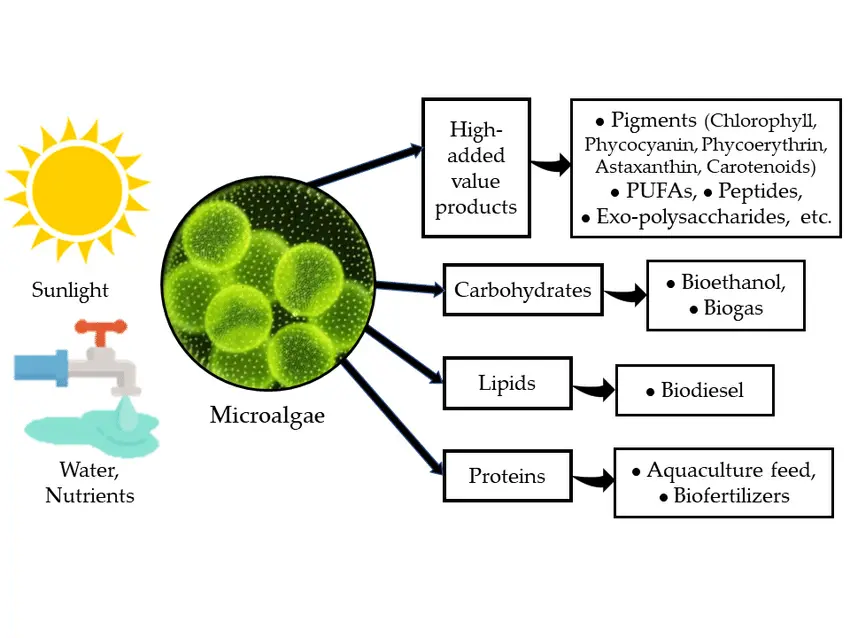
What are Microalgae and Macroalgae ?
- Microalgae:
- Microalgae are tiny photosynthetic organisms found in various natural environments such as water, rocks, and soil.
- They exhibit higher photosynthetic efficiency compared to terrestrial plants and contribute significantly to global oxygen production.
- Microalgae thrive in both freshwater and marine habitats, examples include Chlorella and Diatoms. Marine microalgae are crucial in oceanic food chains and absorb carbon dioxide.
- However, ongoing climate change and global warming are causing surface ocean waters to warm, leading to reduced nutrient availability due to decreased mixing between nutrient-rich deeper waters and surface waters.
- Macroalgae:
- Macroalgae, commonly known as seaweeds, are multicellular autotrophs categorised into three groups based on thallus colour: Chlorophyta (green algae), Rhodophyta (red algae), and Phaeophyta (brown algae).
- Seaweeds lack roots, stems, and leaves typical of land plants and are foundational in marine ecosystems.
- They form dense underwater forests called kelp forests, which serve as critical habitats for various marine organisms including fish, snails, and sea urchins.
- Some species of seaweeds include Gelidiella acerosa, Gracilaria edulis, Gracilaria crassa, and Gracilaria verrucosa, each playing distinct roles within marine environments.
|
UPSC Civil Services Examination, Previous Year Question (PYQ) Prelims: Q:1 Consider the following statements in respect of probiotics: (2022)
Which of the statements given above is/are correct?
Ans: (c) Mains Q:1 What are the research and developmental achievements in applied biotechnology? How will these achievements help to uplift the poorer sections of the society? (2021) Q:2 How can biotechnology help to improve the living standards of farmers? (2019) |
Nitrous oxide emissions up 40% in 40 years
Why in the news?
- In a recent study by the Global Carbon Project (GCP) titled "Global Nitrous Oxide Budget (1980-2020)", nitrous oxide emissions have shown a continuous increase of 40% from 1980 to 2020.
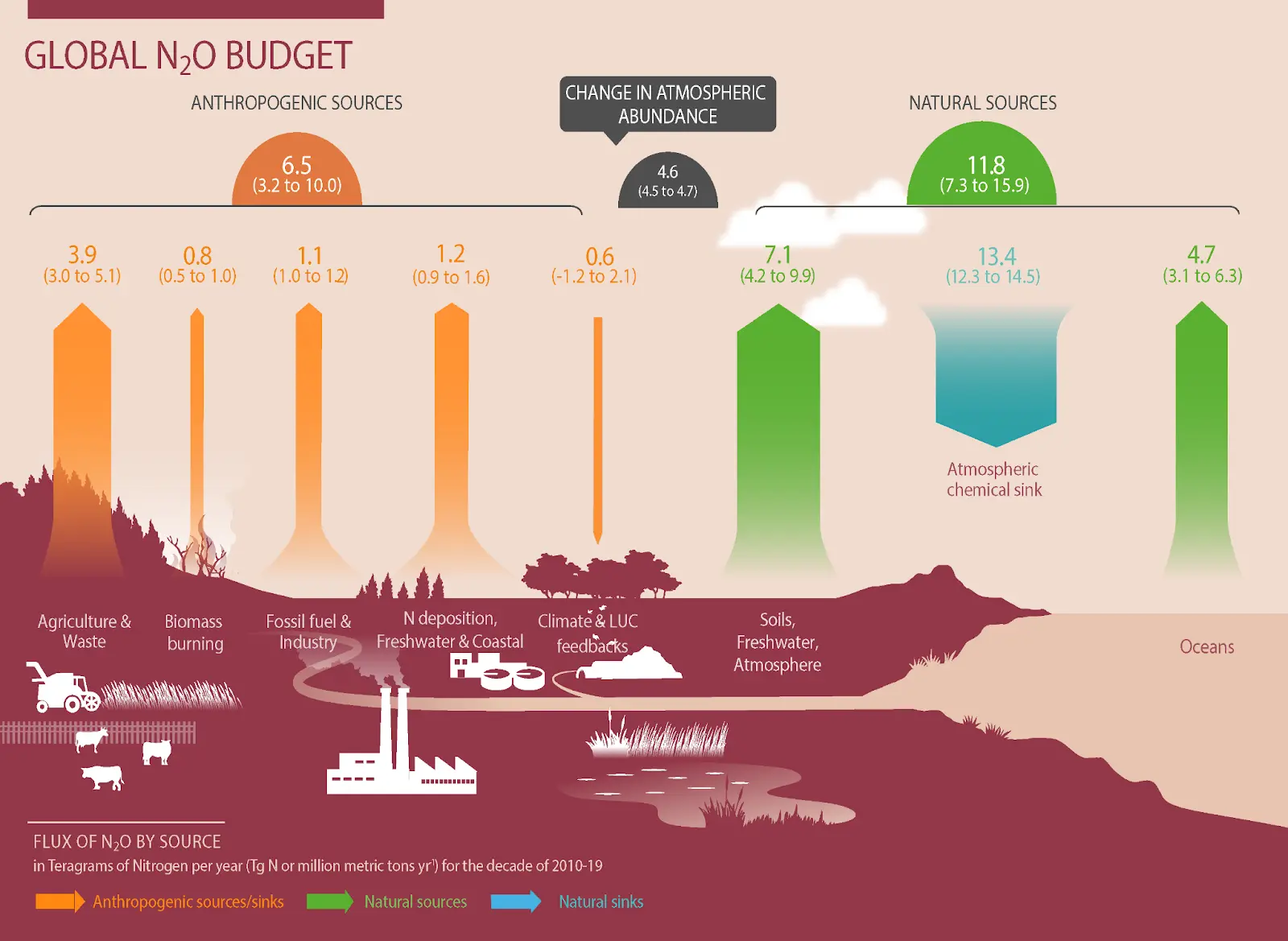
About Nitrous Oxide (N2O):
- Nitrous oxide (N2O), an odourless and colourless gas, is non-flammable but supports combustion to the same extent as oxygen, leading to its colloquial name, 'laughing gas'.
- It is soluble in water and its vapours are heavier than air.
Applications:
- Medical Use: Nitrous oxide serves as an anaesthetic and analgesic in dentistry and surgery, often combined with oxygen to provide sedation and pain relief during procedures.
- Automotive Industry: In motorsports, nitrous oxide enhances engine power output for performance enhancement.
- Food Industry: Nitrous oxide acts as a propellant in whipped cream dispensers, contributing to a light and fluffy texture.
- Chemical Industry: Used as an oxidising agent in specific chemical reactions and processes.
- Environmental Monitoring: Utilised to calibrate gas chromatographs and other analytical instruments essential for environmental monitoring and research.
- Recreational Use: Nitrous oxide is sometimes used recreationally for its euphoric and dissociative effects.
- Aerospace Industry: In the aerospace sector, nitrous oxide functions as a hybrid rocket propellant, providing oxidising properties for rocket engines.
Environmental Impact of Nitrous Oxide (N2O):
- Greenhouse Gas: Nitrous oxide is a potent greenhouse gas that traps heat in the atmosphere, intensifying the greenhouse effect and global warming.
- Global Warming Potential (GWP): N2O has a global warming potential approximately 298 times greater than that of carbon dioxide (CO₂) over a 100-year period. This high GWP indicates that nitrous oxide has a much stronger heat-trapping capability per molecule compared to CO₂.
- Atmospheric Lifetime: Nitrous oxide remains in the atmosphere for about 114 years, contributing to its long-term impact on climate change by persisting and accumulating over time.
- Climate Change: Nitrous oxide (N2O) acts as a greenhouse gas, contributing to global warming and thereby exacerbating climate change impacts. These include more frequent and severe weather events, sea-level rise, and disruptions to ecosystems.
- Ecosystem Effects: Nitrous oxide emissions from agriculture can cause nutrient imbalances in soils and water bodies, which in turn affect plant growth and aquatic life.
Key findings of the study:
- Alarming Rise in Nitrous Oxide (N2O) Emission: Nitrous oxide emissions from human activities have increased by 40% (3 million metric tons of N2O per year) between 1980 and 2020.
- Top 5 Emitters of N2O: The largest emitters of N2O are China (16.7%), India (10.9%), US (5.7%), Brazil (5.3%), and Russia (4.6%). India ranks as the second-largest emitter of N2O globally after China.
- Per-Capita Emissions: In per capita terms, India has the lowest emission of N2O at 0.8 kg N2O/person, lower than China (1.3), US (1.7), Brazil (2.5), and Russia (3.3).
- Atmospheric Concentration: The concentration of atmospheric N2O reached 336 parts per billion in 2022, marking a 25% rise over pre-industrial levels, which exceeds previous estimates by the Intergovernmental Panel on Climate Change (IPCC).
- Emission Pattern in Regions: Among the 18 regions analysed in this study, only Europe, Russia, Australasia, Japan, and Korea experienced decreasing nitrous oxide emissions.
- Europe showed the most significant decrease between 1980 and 2020, attributed to reductions in fossil fuel and industrial emissions.
- China and South Asia recorded the largest increases in N2O emissions during the same period, with a rise of 92%.
- Technological Challenge: The study highlights that currently, no technologies exist that can effectively remove N2O from the atmosphere.
Sources of Nitrous Oxide Emissions:
- Agriculture: The primary source of nitrous oxide emissions is agriculture, specifically from the use of synthetic fertilisers and management of livestock manure. Microbial processes in soils and water bodies convert nitrogen compounds into N2O.
- Industrial Processes: Certain industrial activities, such as the production of nitric acid and adipic acid (used in fertilisers and nylon production), also release significant amounts of N2O.
- Combustion: Nitrous oxide can be produced from the combustion of fossil fuels and biomass, although emissions from these sources are relatively minor compared to agriculture.
- Waste Management: Activities such as wastewater treatment and the decomposition of organic waste in landfills are additional contributors to nitrous oxide emissions.
- Natural sources: Natural sources, including oceans, inland water bodies, and soil, accounted for 11.8% of global nitrous oxide (N2O) emissions between 2010 and 2019.
Proposed Solutions to Mitigate Nitrous Oxide (N₂O) Emissions:
- Innovative Agricultural Practices:
- Precision Agriculture: Utilising soil sensors and advanced technologies to optimise fertiliser application can reduce unnecessary nitrogen input, thereby minimising N₂O formation and decrease emissions by up to 50%.
- Nitrification Inhibitors: These additives slow down the conversion of ammonium in fertilisers to nitrate, a form readily used by N₂O-producing microbes.
- Cover Cropping: Planting cover crops during fallow periods helps retain soil moisture and nitrogen, reducing the risk of N₂O release.
- Anti-Methanogenic Feed: Introducing anti-methanogenic feeds like 'Harit Dhara' (HD) or similar innovations can reduce methane and nitrogen emissions from cattle.
- Nano-Fertilisers:
- Nano-fertilisers deliver nutrients directly to plant roots in a controlled manner, reducing excess nitrogen and consequently lowering nitrous oxide emissions.
- Effective Policy Measures:
- Emission Trading Schemes: Implementing cap-and-trade systems for N₂O emissions can incentivize industries and farmers to adopt cleaner practices.
- Targeted Subsidies: Governments can provide financial incentives for farmers transitioning to sustainable practices that minimise N₂O emissions.
- Research and Development: Increased funding for research into N₂O mitigation strategies, including improved fertilisers and waste management techniques, is critical for advancing sustainable solutions.
- Addressing Emissions from Other Sources:
- Industrial Processes: Enforcing stricter regulations and promoting cleaner technologies in industries like nylon production and nitric acid manufacturing can curb rising N₂O emissions.
- Combustion: Optimising combustion processes in vehicles and power plants, as recommended by the IPCC Climate Change 2021 report, can help reduce N₂O emissions as a by-product.
- Waste Management: Advancements in waste-to-energy conversion and effective treatment of wastewater and agricultural waste can significantly decrease N₂O emissions from these sources.
|
UPSC Civil Services Examination, Previous Year Question: Prelims Q:1 Which of the following add/adds nitrogen to the soil? (2013)
Select the correct answer using the codes given below:
Ans: (c) Q:2 Which one of the following sets of elements was primarily responsible for the origin of life on the Earth? (2012)
Ans: (b) Q:3 Which feature of some species of blue-green algae helps promote them as bio-fertilizers? (2010)
Ans: (c) Mains: Q:1 Sikkim is the first ‘Organic State’ in India. What are the ecological and economical benefits of Organic State? (2018) |
Source: TH
Jyotirmath and Pargana Shri Kainchi Dham
Why in the news:
- Recently, the Centre approved the Uttarakhand government’s proposal for renaming the Joshimath tehsil in Chamoli district to Jyotirmath, and the Kosiyakutoli tehsil in Nainital district to Pargana Shri Kainchi Dham tehsil.
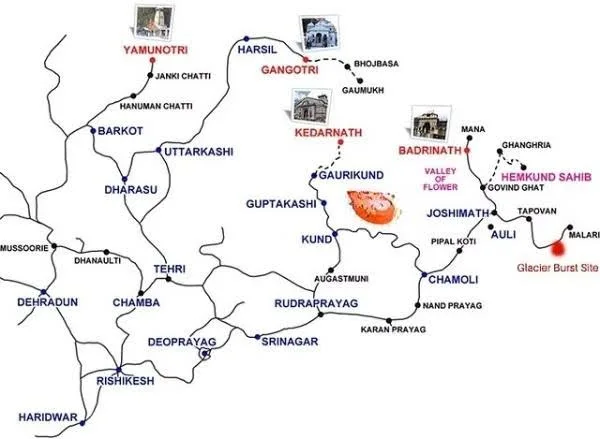
Jyotirmath:
- Jyotirmath (also known as Jyotir Peeth) is a small town located at a height of 1,890 mts (6150 feet).
- Over time, the local population began referring to the area as “Joshimath”, which was recorded in the government records by the Britishers.
- Thus, while “Jyotirmath” was used in a more formal or religious context, “Joshimath” became the more commonly used name.
- It is one of the four cardinal mathas (monasteries) that 8th century philosopher Adi Shankaracharya is believed to have established across India to promote the Advaita Vedanta philosophy.
- Jyotirmath was established to preserve and disseminate spiritual knowledge and practices. The name “Jyotirmath” comes from the divine light of knowledge he is said to have attained, with ‘jyoti’ meaning divine light.
- It is also the home of the oldest tree of India, Amar Kalpavriksha, under which Adi Shankaracharya performed penance.
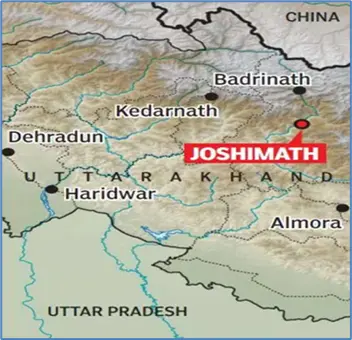
From Kosiyakutoli to Pargana Shri Kainchi Dham:
- In “Kosiyakutoli”, “Kosi” refers to the river that flows through the Nainital district and “kutoli” is derived from the local language, referring to a village or settlement.
- Kosiyakutoli came to be known for its association with Neem Karoli Baba and the Kainchi Dham Ashram he founded in 1962.
- Neem Karori Baba is a renowned Hindu guru and saint with followers in India and abroad. He passed away in 1973. He is revered for his teachings on bhakti yoga and devotion to God.
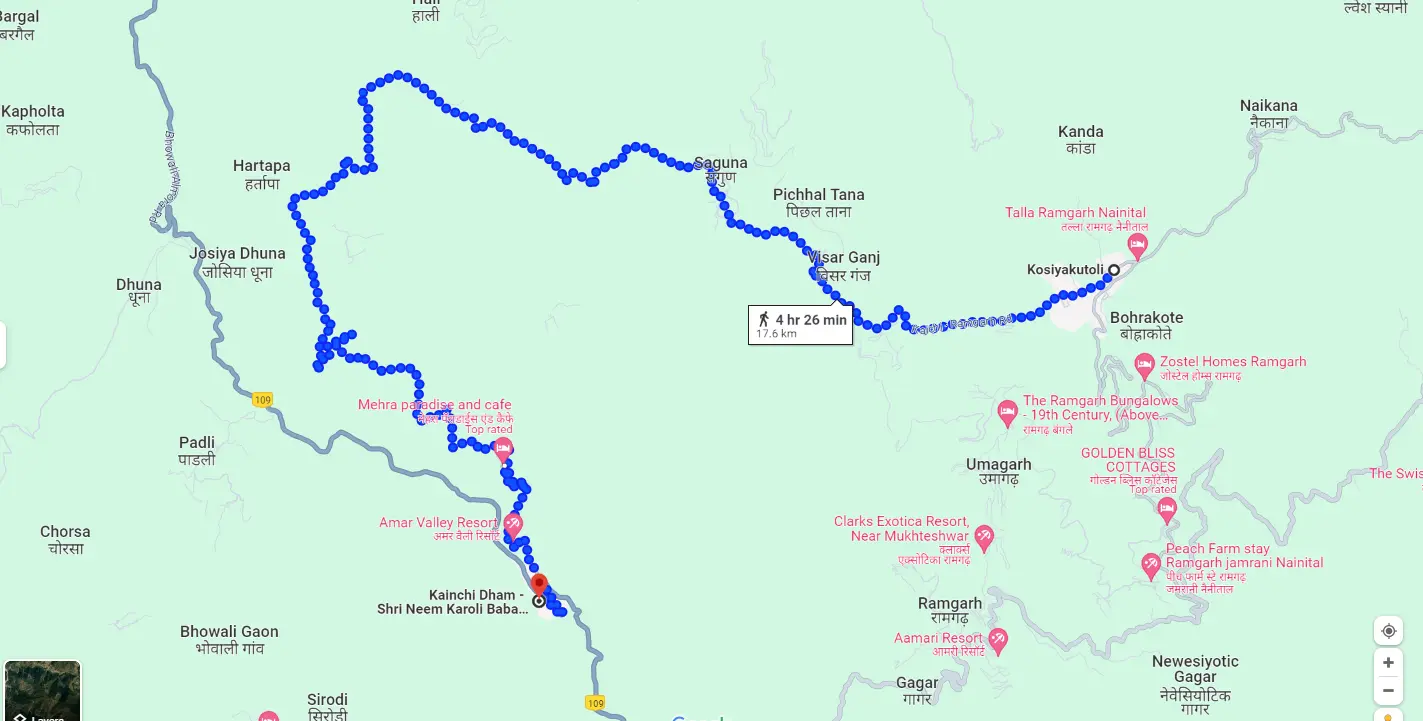
Source: (IE)
Baobab tree (Adansonia digitata) in India
Why in the news:
- Recently,Baobabs are found in India, from semi-arid central areas to wetter Western Ghats.

- Adansonia digitata is native to Africa and belongs to the Malvaceae family. There are eight species of Adansonia worldwide, found in Africa, Asia and Australia.
- Baobab trees in India were introduced by African migrants and Arab and Portuguese traders.
- Locals in Mandu (MP) believe the baobab seeds were brought by Afghan rulers of the Ghuri Dynasty during the reign of Hoshang Shah of Malwa.
- The tree commemorates the French botanist Michel Adanson, who studied Senegal’s natural history, with ‘digitata‘ referring to the hand-shaped leaves.
- “Baobab” is derived from the Arabic “bu hibab,” which means “fruit with several seeds.”
- The tree is also known by other names, such as
- ‘dead-rat tree’ (due to its fruit’s resemblance to dead rats),
- ‘monkey-bread tree’ (since monkeys eat its dry fruit),
- ‘upside-down tree’ (because it's bare branches resemble roots),
- ‘cream of tartar tree’ (due to the acidic taste of its fruit).
- In Hindi, it is referred to as gorakh-imli or gorakh-chinch. It is also revered as the “Tree of Life” and “Mother of the Forest,” symbolising resilience and cultural richness.
- Multi-purpose tree: Food, clothing, medicine, ornamental purposes and raw materials. The Bhil community in MP preserves these trees and makes a living by collecting and selling various baobab products.
- Superfruits: Cucumber-shaped fruits and leaves are high in nutrients. Its nutritional profile includes protein, fat, carbohydrates, fibre, calcium, magnesium, Vitamin C, and potassium.
- Heritage tree: Cultural and religious significance, like the heritage baobab tree in Goa.
- Physical properties include
- Appearance: Deciduous trees grow up to 20-30 m with a trunk diameter of 2-10 m, smooth, reddish-brown to grey bark with longitudinal fibres.
- Water storing trunks: Distinctive swollen, bottle-shaped trunk that stores water for dry seasons.
- Soil: Well-drained, acidic soils.
- Blooming: Both wet and dry seasons in Southern Africa from October to December, with fruits appearing from April to May. In India, they flower from May to June, aligning with the rainy season.
- Unique properties: Resist fire, termites & drought. Extensive roots.
- According to the Guinness Book of World Records, the largest known living baobab tree is around 800 years old and is in Sagole, South Africa, near the Zimbabwe border.
- The largest baobab tree outside Africa in India is located at Golconda Fort. It is over 400 years old and is known locally as hatiyan jhad (elephant tree).
Source: (DTE)
Seabirds
Why in the news:
- Recently, Cyclone Ilsa (category 5 cyclone) that crossed Bedout Island wiped out 80-90 percent of the island’s seabird (Masked bobby, brown bobby and lesser frigatebird) population.
- Bedout Island is located in the Timor Sea off the remote north coast.

Categories of Cyclone:
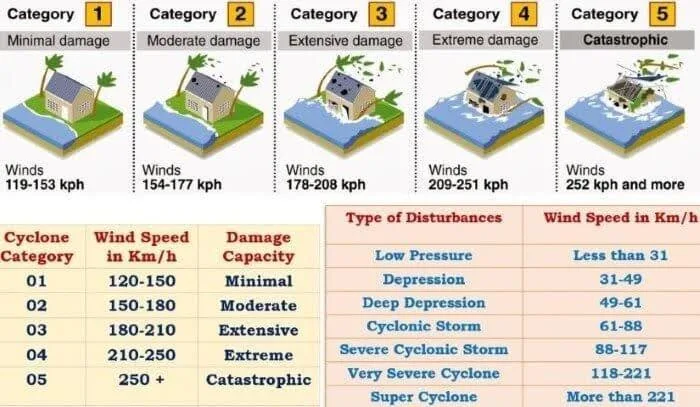
Seabirds:
- Seabirds are bird species adapted to live and feed in the saltwater environment of the ocean.
- They contribute to the health of islands and the reefs that surround them.
- They connect the marine and terrestrial ecosystems by transporting marine-derived nutrients to terrestrial breeding, roosting, and nesting areas via guano deposition and other means.
Masked Booby (Sula dactylatra bedouti):

- The masked booby is a large, white gannet-like seabird with black trailing edges to the wings, a black tail and yellow bill.
- They range widely over tropical and subtropical open ocean.
- IUCN Status: Least Concern
Brown Booby (S leucogaster):

- The brown booby is a large, chocolate-brown-and-white seabird.
- Distribution: Tropical seas of the Indian, Pacific and Atlantic Oceans, plus the Caribbean Sea.
- IUCN Status: Least Concern
Lesser Frigatebird (Fregata ariel):

- Lesser frigatebirds are large, predominantly black birds with long narrow wings, a deeply forked tail and a long hooked bill.
- Distribution: They are found throughout the Indian Ocean, the western and central Pacific Ocean, and off Brazil in the Atlantic Ocean.
- IUCN Status: Least Concern
Source: (DTE)
Rift Valley Fever (RVF)
Why in the news ?
- A recent study has revealed that the geographical range of Rift Valley Fever (RVF) disease clusters is expanding across eastern Africa.
- The increasing frequency of small RVF clusters in previously unaffected areas is associated with a combination of higher temperature and rainfall.
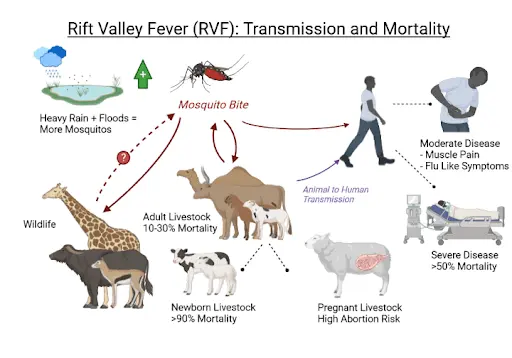
- Rift Valley fever (RVF) is a zoonotic viral disease caused by the Rift Valley fever virus, which is found in most of sub-Saharan Africa, especially eastern and southern Africa.
- It was first identified in 1931 in the Rift Valley in Kenya.
- It is transmitted by mosquitoes, most commonly the Aedes and Culex mosquitoes.
- It is primarily a disease of ruminants such as sheep, goats and cattle but human infections occur following close contact with infected animal tissue and body fluids.
- Symptoms: People with RVF often have either no symptoms or a mild illness that includes fever, weakness, back pain, and dizziness.
- It produces high mortality rates in newborn ruminants, especially sheep and goats, and abortion in pregnant animals.
- RVF is listed in the World Organisation for Animal Health (WOAH) Terrestrial Animal Health Code and must be reported to the WOAH.
Source: (DTE)
India’s Prospects Through Artificial General Intelligence
Why in the news ?
- Recently, it has been observed that Artificial General Intelligence (AGI) has the potential to redefine and shape India's future prospects on the global stage for coming generations.

Understanding AGI:
- Definition: AGI refers to artificial intelligence systems with general intelligence comparable to or exceeding human cognitive abilities across nearly all areas.
- Concept: AGI represents a futuristic vision where machines possess cognitive abilities on par with humans, capable of reasoning, problem-solving, perception, learning, and language comprehension.
- Capabilities: Unlike AI designed for specific tasks, AGI can generalise its capabilities to solve any problem, even those it wasn't explicitly programmed to handle.
|
The Indian AI Mission:
|
Journey Towards AGI:
- Current AI Limitations:
- Despite significant advancements, no AI tool has yet passed the Turing test, a benchmark proposed by 20th-century computer scientist Alan Turing.
- This test measures an AI's ability to exhibit intelligent behaviour equivalent to, or indistinguishable from, that of a human.
- Prediction Machines:
- Current state-of-the-art AI technologies, including ChatGPT, DALL-E, and others, function primarily as prediction machines.
- They predict answers to specific prompts with high accuracy because they have been trained on vast amounts of data.
- Human-Level Performance:
- These AI systems lack human-level capabilities in areas such as creativity, logical reasoning, and sensory perception.
- They do not yet exhibit the comprehensive cognitive flexibility and problem-solving abilities characteristic of human intelligence.
- Paradigm Shift with AGI:
- The advent of AGI represents a significant shift in our technological future and its societal role. Our adoption and management of AGI will not only shape our global standing but also define the legacy for future generations.
- Transformative Power of AI:
- AI's potential to enhance human life is widely recognized. It is crucial to approach this future with a strong sense of responsibility and a collective vision to ensure technology benefits the greater good.
- Future with AGI:
- Achieving success with AGI will transcend leading in technology; it will involve mastering a domain that could influence human evolution, economics, and global governance. Mastery of AGI could ultimately determine the future balance of global power.
Potential Benefits of AGI:
- Healthcare:
- In India, it could bridge the gap between urban and rural healthcare services by monitoring health metrics in real-time, predicting potential problems, and coordinating customised preventative care and treatments.
- Agriculture:
- AGI can optimise crop yields, manage pests, and monitor soil health. In India, it could assist small and marginal farmers in making informed decisions, thereby improving productivity and sustainability.
- Education:
- It has the potential to democratise quality education across India, ensuring that students in remote areas receive the same quality of education as those in urban centres.
- Governance:
- In India, it could ensure efficient public service delivery even in the remotest parts of the country, thereby improving governance and accountability
Risks and Challenges Associated with AGI:
- Understanding the Risks:
- The National Institute of Standards and Technology (NIST) has developed an AI Risk Management Framework to help mitigate the risks associated with AGI.
- This framework identifies 12 risks and proposes over 400 actions that developers can implement to manage these risks effectively.
- Long-term Risks:
- Yuval Noah Harari has highlighted a long-term risk involving the potential convergence of AGI and biotechnology.
- This convergence could fundamentally alter human existence by manipulating human emotions, thoughts, and desires.
- Regulatory Challenges:
- Regulatory sandboxes have emerged as a crucial tool for evaluating innovations within a controlled and monitored environment.
- These sandboxes enable policymakers to gather empirical evidence on the benefits and risks associated with AGI applications.
- Ethical Considerations:
- Ensuring that AI-based decisions are ethical, fair, and well-documented is essential to mitigate risks.
- There are concerns that AGI could potentially disadvantage individuals or groups through discriminatory practices, emphasising the need to align AGI development with universally accepted human values.
Policy Suggestions:
- Preparing for AGI-Driven Economy and Defence Integration: India needs to anticipate how AGI will transform job markets and economic structures while ensuring safe integration into defence strategy, acknowledging the tendency to under-prepare for rare catastrophic risks.
- Establishing an AI Department: India should create a dedicated AI department to centralise coordination of all AI-related activities, setting standards, guidelines, and policies aligned with national strategic interests.
- Democratising Data Access: India must liberate access to vast datasets across public and private sectors to foster a competitive AI ecosystem capable of addressing global and local challenges effectively.
- Enhancing National Security through AI: India should develop a robust AI ecosystem for strategic applications in defence, drone technology, cybersecurity, and other critical sectors to bolster national security and drive innovation.
- Nationwide AI Skilling Initiative: Launching a comprehensive AI skilling initiative is crucial, aiming to train 50 million people in AI usage skills and 1 million in AI development to meet future workforce demands.
- Fostering Collaborations and Partnerships: India should forge partnerships with universities, technical institutes, and online education platforms to integrate AI-focused curricula, establish specialised degree programs, and promote continuous education opportunities nationwide.
Conclusion:
Thus. AGI offers significant potential for enhancing human life and economic competitiveness but introduces new risks and challenges. Striking a balance between fostering innovation and ensuring responsible development is crucial. Addressing current challenges and anticipating future impacts is essential as we navigate the uncharted territory of AGI to secure a safe and beneficial future.
|
UPSC Civil Services Examination, Previous Year Question (PYQ) Prelims Q1. With the present state of development, Artificial Intelligence can effectively do which of the following? (2020)
Select the correct answer using the code given below:
Ans: (b) |
Source: LM
Transforming India's Healthcare
Context:
- India's healthcare system comprises a complex network of public and private facilities, striving to cater to its large population.
- While the private sector plays a significant role in providing healthcare services, recent events such as the fire at a nursing home in Delhi underscore a crucial challenge to the inadequacy of healthcare regulations in India.
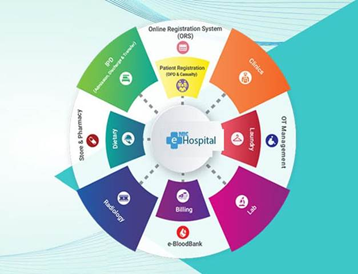
What is the Framework of Healthcare Regulation in India?
- Historical Regulatory Landscape:
- During Colonial Times: Fragmented regulations influenced by colonial governance, such as the Madras Public Health Act of 1939.
- Bhore Committee Report (1946): Advocated for the integration of preventive, promotive, and curative healthcare services and the establishment of Primary Health Centres in rural areas.
- Economic Liberalisation (1991): Led to the expansion of private healthcare, necessitating updated regulations.
- Key Regulatory Bodies:
- Ministry of Health and Family Welfare (MoHFW): Formulates overarching healthcare policies.
- National Medical Commission (NMC): Regulates medical education and licensure, replacing the Medical Council of India under the NMC Act, 2019, to enhance transparency.
- Others: Include the Nursing Council and Pharmacy Council.
- Major Regulatory Laws and Policies:
- Pre-Conception and Pre-Natal Diagnostic Techniques Act, 1994: Aims to prevent female foeticide.
- Clinical Establishments (Registration and Regulation) Act, 2010: Mandates registration and standard treatment guidelines for clinical facilities.
- Drugs and Cosmetics Act, 1940: Regulates pharmaceuticals.
- Consumer Protection Act, 1986: Initially did not explicitly cover healthcare services, but subsequent court rulings interpreted its scope to include healthcare.
- National Health Policy, 2017: Sets out a vision for universal health coverage.
What are the Major Challenges Related to India’s Healthcare System?
- Public Health Expenditure Gap: Despite ranking as the world's fifth-largest economy, India allocates only 2.1% of its GDP to healthcare in FY23, leading to high out-of-pocket expenses for citizens, amounting to 47.1%.
- Urban-Rural Healthcare Disparity: India's healthcare infrastructure heavily favours urban areas, leaving rural regions underserved. While 65% of the population resides in rural areas, they have access to only 25-30% of healthcare facilities, challenging India's constitutional commitment to equality.
- Rising Non-Communicable Diseases (NCDs): NCDs account for 64% of India's disease burden, with diabetes alone affecting 77 million people in 2019 and projected to rise to 134 million by 2045. Despite this, public health efforts remain primarily focused on infectious diseases, neglecting the growing NCD burden.
- Mental Health Crisis: India faces a severe shortage of mental health professionals, with only 0.75 psychiatrists per 100,000 people and minimal allocation (0.05%) of the health budget towards mental health. Consequently, India grapples with 36.6% of global suicides.
- Telemedicine Disparity: While telemedicine emerged as a solution during the Covid-19 pandemic, India's digital divide hampers its effectiveness. Rural areas, despite having the second-largest number of internet users globally, lag behind urban areas, exacerbating healthcare inequities.
- Climate Change Impact: Climate change poses significant health risks, with air pollution alone contributing to 1.67 million deaths in India in 2019. Additionally, heatwaves affect crop yields, directly impacting nutrition and public health.
- Governance Challenges: India's healthcare sector faces governance disparities, with bureaucratic hurdles and favouritism towards large corporate hospitals. This governance conundrum hinders efficient healthcare delivery, particularly for smaller clinics and nursing homes.
- Pharmaceutical Credibility Crisis: Despite being a major supplier of generic drugs globally, India's pharmaceutical industry faces credibility issues, as highlighted by incidents like the 2022 cough syrup tragedy in Gambia.
- Neglect of Preventive and Primary Care: India's healthcare system prioritises curative, hospital-based care over preventive measures and primary care. This neglect results in escalating costs and a burden of preventable diseases, perpetuating a cycle of illness and expenditure.
What Measures can be Adopted to Revamp India’s Health Sector?
- Risk-Based Regulatory Reform: Introducing a tiered regulatory system based on facility complexity and risk to streamline approvals and ensure stringent oversight, with a focus on outcome-based regulations.
- Health-Education-Livelihood (HEL) Campuses: Establishing integrated rural campuses with health centres, skill development centres, and health-tech incubators to boost healthcare human resources and local economies.
- "Pharma-to-Plate" Integrity Chain: Implementing a blockchain-based tracking system for pharmaceutical products to combat counterfeit drugs and ensure high-quality medications, supported by a global tracking app.
- Mental Wealth Initiative: Promoting mental health as an economic asset through corporate tax breaks, integrating mental health modules into professional courses, and training local providers to offer counselling services.
- Ayush Integration: Increasing AYUSH practitioners in allopathic healthcare settings and introducing wellness sessions in schools and workplaces to foster holistic healthcare and prevent non-communicable diseases.
- Climate Clinics: Deploying mobile clinics in climate-vulnerable areas, upgrading primary healthcare centres for climate resilience, and utilising health data to predict climate-related impacts and improve farming practices.
- Expansion of ABHA: Nationwide promotion of Ayushman Bharat Health Accounts (ABHA) and the use of artificial intelligence for hyperlocal public health strategies to enhance preventive care and overall healthcare outcomes.
- Women-Led Health Panchayats: Establishing all-women health councils in every panchayat to audit local health facilities, allocate health funds, and improve rural health governance, empowering women and improving health outcomes.
|
UPSC Civil Services Examination, Previous Year Questions (PYQs) Prelims Q:1 Which of the following are the objectives of the ‘National Nutrition Mission’? (2017)
Select the correct answer using the code given below:
Ans: (a)
Mains Q:1 “Besides being a moral imperative of a Welfare State, primary health structure is a necessary precondition for sustainable development.” Analyse. (2021) |
Source: TH
50th Year of the Imposition of Emergency in India
Why in the news ?
- India marked the fiftieth anniversary of the imposition of Emergency, declared by then-PM Indira Gandhi on June 25, 1975.
- Which lasted for 21 months, leaving a profound impact on Indian politics with its suspension of civil liberties, curtailment of press freedom, mass arrests, cancellation of elections, and rule by decree.
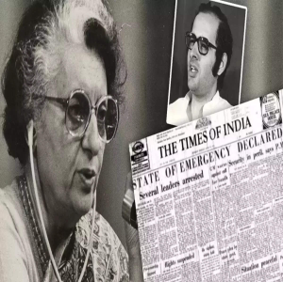
What is an emergency ?
- An emergency refers to legal provisions within a country's constitution or laws that empower the government to swiftly and effectively address extraordinary situations jeopardising national stability, security, sovereignty, or democracy.
- In India, these provisions are enshrined in Articles 352 to 360 under Part XVIII of the Constitution.
- These constitutional measures draw inspiration from Germany's Weimar Constitution, enabling the government to respond to crises such as war, rebellion, or other threats to the nation's well-being.
About the National Emergency (Article 352):
- Under Article 352 of the Indian Constitution, the President can declare a National Emergency if satisfied that the security of the country or any part thereof is threatened by war, external aggression (External Emergency), or armed rebellion (Internal Emergency).
- The term ‘armed rebellion’ replaced ‘internal disturbance’ through the 44th amendment.
- Powers Granted:
- The declaration allows the government to suspend fundamental rights (except Articles 20 and 21) to address the crisis effectively.
- Duration and Parliamentary Approval:
- The proclamation of emergency must be approved by both houses of Parliament within one month.
- If issued when the Lok Sabha is dissolved, it remains valid until 30 days from the first sitting of the Lok Sabha after reconstitution, provided the Rajya Sabha has approved it.
- The Emergency lasts initially for 6 months and can be extended indefinitely with Parliament's approval every six months, requiring a special majority.
- Revocation:
- The President can revoke the Emergency at any time by a subsequent proclamation without parliamentary approval.
- It must be revoked if the Lok Sabha passes a resolution disapproving its continuation by a simple majority.
- Applicability:
- A National Emergency can apply to the entire country or specific parts.
- The 42nd Constitutional Amendment Act (1976) allowed the President to limit its operation to certain regions.
- Judicial Review:
- The 38th Constitutional Amendment Act (1975) made the declaration immune to judicial review.
- The 44th Constitutional Amendment Act (1978) repealed this provision, restoring the judiciary's authority to review National Emergency declarations.
- Minerva Mills Case (1980): The Supreme Court ruled that a National Emergency proclamation can be challenged in court if based on malafide intent or irrelevant facts
|
Some of many Examples of Imposition of President Rule:
|
Political and Social Circumstances in India Leading up to the Emergency:
- January 1966: Indira Gandhi is elected Prime Minister.
- November 1969: The Congress party splits after Gandhi is expelled for violating party discipline.
- 1973-75: Surge in political unrest and demonstrations against the Indira Gandhi-led government.
- 1971: Political opponent Raj Narain lodges a complaint of electoral fraud against Indira Gandhi.
- June 12, 1975: Allahabad High Court finds Gandhi guilty of discrepancies in her electoral campaign.
- June 24, 1975: Supreme Court grants a conditional stay on the Allahabad HC verdict, declaring Gandhi's election to the Lok Sabha null and void. The SC also asks Gandhi to stay away from parliamentary proceedings.
- June 25, 1975: Declaration of Emergency by President Fakhruddin Ali Ahmed on the advice of Indira Gandhi. According to the government’s press note, certain persons were inciting the police and armed forces to not discharge their duties.
- June 26, 1975: Indira Gandhi addresses the nation on All India Radio.
End of Emergency and Afterwards:
- January 18, 1977: Indira Gandhi calls for fresh elections and releases all political prisoners.
- March 1977: The elections lead to a comprehensive defeat for Indira Gandhi, and Morarji Desai becomes India’s first non-Congress (Janata Party) Prime Minister.
- March 23, 1977: Emergency officially ends.
- The Shah Commission, constituted by the Janata government, finds the decision to impose Emergency to be unilateral and adversely affecting civil liberties.
What Happened During the Emergency?
- Suspension of civil liberties:
- Almost all opposition leaders (including JP) are detained, and about 36,000 people are imprisoned under the Maintenance of Internal Security Act (MISA).
- Newspapers are subjected to pre-censorship. In September 1976, Sanjay Gandhi initiated a mass forced sterilisation program in Delhi.
- Legal changes pushed through by Parliament:
- With the opposition in jail, Parliament passes the Constitution (38th Amendment) Act that bars judicial review of the Emergency.
- The Constitution (39th Amendment) Act says that the election of the Prime Minister cannot be challenged in the Supreme Court.
- The Constitution (42nd Amendment) Act makes changes to a range of laws, including taking away the judiciary’s right to hear election petitions, widening the authority of the Union to encroach on State subjects, and making any law passed by Parliament to implement any or all directive principles of state policy immune to judicial review.
- Changes pushed through by the Courts:
- In the famous case of ADM Jabalpur vs Shivkant Shukla (1976), the SC rules that detention without trial is legal during an emergency.
What were the Impacts of Imposing National Emergency in 1975?
- Constitutional Changes:
- Constitution (39th Amendment) Act, 1975:
- Enacted in response to the Allahabad High Court's ruling declaring Prime Minister Indira Gandhi's election void.
- Placed disputes involving the President, Vice President, Prime Minister, and Speaker beyond the judiciary's scope.
- Added certain Central Acts to the Ninth Schedule.
- Constitution (42nd Amendment) Act, 1976:
- Significantly increased the central government's authority and the Prime Minister's office by:
- Allowing deployment of forces in states and overriding state laws during emergencies.
- Limiting judicial review of laws and amendments, reducing their accountability.
- Extending the terms of Parliament and state assemblies.
- Allowing laws to override fundamental rights in cases of activities deemed anti-national.
- Significantly increased the central government's authority and the Prime Minister's office by:
- Constitution (44th Amendment) Act, 1978:
- Aimed to rectify the imbalances created by the 42nd Amendment.
- Restored the primacy of fundamental rights by:
- Limiting the suspension of rights: Article 21, protecting the right to life and liberty, could not be suspended during any emergency.
- Reinforcing judicial review: Strengthening the Supreme Court's power to review presidential proclamations of emergency.
- Requiring the President to act on the written recommendation of the cabinet before declaring a national emergency under Article 352.
- Constitution (39th Amendment) Act, 1975:
- Emergency Acted as a Vaccine Against Dictatorship:
- The period of emergency from 1975 to 1977 underscored the importance of democracy and highlighted the dangers of unchecked executive authority.
- This recognition has spurred efforts to strengthen democratic systems by imposing constraints on the Prime Minister's powers during crises.
- Emergency Undermined Democratic Integrity:
- The emergency period saw severe curtailment of civil liberties under acts like the Maintenance of Internal Security Act (MISA) and Defence of India Rules (DIR).
- This exposed vulnerabilities in democratic institutions and fostered scepticism about leadership.
- Vocalism About Rights:
- Strict media control during the emergency stifled dissent, leading to the emergence of grassroots movements and underground press advocating for human rights.
- Examples include the Navnirman Andolan in Gujarat, the Jayaprakash Narayan Movement in Bihar, and the George Fernandes-led Railway Strike.
- Evolving Role of Judicial Activism:
- The emergency period highlighted shifts in judicial activism, with the ADM Jabalpur case initially upholding the suspension of fundamental rights, sparking criticism.
- Subsequent rulings, like those in habeas corpus petitions and the Maneka Gandhi case, reaffirmed a commitment to protect fundamental rights and bolstered judicial review in India.
- Changes in Political Parties' Attitude:
- The emergency united opposition parties that had been previously divided, emphasising the importance of a robust opposition in a democracy.
- It also made political parties cautious about resorting to similar measures in the future, valuing democratic processes and constitutional norms.
How did the Emergency Change Indian Politics?
- Dented the Congress’ reputation: A party that led the struggle for civil liberties against the colonial state.
- First non-Congress government: The Janata experiment gives India its first non-Congress government, but its collapse also demonstrates the limits of anti-Congressism.
- Emergence of young leaders: The Emergency gives India a crop of young leaders (Lalu Prasad Yadav, George Fernandes, Arun Jaitley, Ram Vilas Paswan, etc.) who dominate politics for decades to come.
- Coming together of the social forces: This results in an increase in the representation of OBCs in Parliament. As a result, the Janata government appoints the Mandal Commission to look into OBC quotas, which goes on to make the rise of the OBCs in North India irreversible.
- Emergency as a part of political vocabulary: Every perceived act of high-handedness by a government is attributed to an “Emergency mindset.”
|
UPSC Civil Services Examination, Previous Year Question (PYQ) Prelims Q:1 Which of the following is/are the exclusive power(s) of Lok Sabha?(2022)
Select the correct answer using the code given below:
Ans: (b) Q:2 With reference to the constitution of India, prohibition or limitations or provisions contained in ordinary laws cannot act as prohibitions or limitations on the constitutional powers under Article 142. It could mean which one of the following?(2019)
Ans: (b) Q:3 If the President of India exercises his power as provided under Article 356 of the Constitution in respect of a particular State, then(2018)
Ans: (b) Mains Q:1 Under what circumstances can the Financial Emergency be proclaimed by the President of India? What consequences follow when such a declaration remains in force? (2018) |
Source: IE
Practice Questions - Current Affairs 15-06-2024
Q1. Which of the following are the principles of the Rule of law?
1. Clarity and accessibility of law
2. Equality before the law
3. Right to participate in the creation of laws
4. Independent judiciary
Select the correct answer using the code given below:
1 and 3 only
1, 2 and 3 only
2 and 4 only
1, 2, 3 and 4
Q2. By which of the following act The rule of the Company was replaced by the rule of the Crown in India.?
Government of India Act of 1858
Government of India Act of 1836
Government of India Act of 1867
Government of India act 1897
Q3. Which of the following factors limits the sovereignty of the Indian Parliament?
1. Written nature of the constitution
2. Federal system of the government
3. System of Judicial review
4. Fundamental rights
Select the correct answer using the code given below:
1, 2 and 3 only
2, 3 and 4 only
1 and 4 only
1, 2, 3 and 4
Q4. Which of the following statements is/are correct regarding the separation of powers as per the Indian Constitution?
1. Judicial conduct of a judge of the Supreme Court cannot be discussed in the Parliament.
2. Validity of proceedings in Parliament and the Legislatures cannot be called into question in any Court.
3. President or the Governor shall not be answerable to any court for the exercise and performance of the powers and duties of his office.
Select the correct answer using the code given below:
1 and 2 only
3 only
1 and 3 only
1, 2 and 3
Q5. Which of the following statements is/are features of Indian Secularism?
1. It is more than a passive attitude of religious tolerance.
2. While French Secularism emphasizes on a strict separation of religion and state, Indian system relies more on what can be termed as ‘Principled Distance approach’
Select the correct answer using the code below.
1 only
2 only
1 and 2 only
None
Q6. Which of the following statements is/are the main functions of Constitution of India?
1. It provides a set of Basic rules to have minimal coordination in the society.
2. It specifies the source of power in making decisions for the society.
3. It sets some limitations upon the powers of government that is exercised against its citizens.
4. It describes the aspirations and goals of the society.
Select the correct answer using the code below.
1 only
1, 2 and 4 only
1 and 2 only
1, 2, 3 and 4
Q7. Which of the following is/are salient features of the Indian Constitution?
1. Strong Centre
2. Federalism
3. Equal protection of the law
4. No taxation without representation
5. Blend of Rigidity and Flexibility
Select the correct answer using the codes given below:
1, 2, 3 and 5
1, 4 , 5
3, 4 , 5
1, 3, 5
Q8. Which of the following is/are correct regarding the Constitution of India?
1. It guarantees rights to a citizen of India.
2. It also sets some limits on what law a government can impose on its citizens.
3. It provides separation of power among different organs of the state.
4. It aims for the creation of a just society.
Select the correct answer using the code given below:
1 and 4 only
2 and 3 Only
1 and 3 only
1, 2, 3 and 4
Q9. Consider the following statements:
1. The Constitution is the organic law of the land and demarcates the responsibilities of the organs of the State.
2. Unwritten constitutions constitute laws made by the Parliament only.
3. Rigid constitutions cannot be amended.
Which of the statements given above is/are correct?
1 only
1 and 2 only
2 and 3 only
1, 2 and 3
Q10. Which of the following are the federal features of the Indian Constitution?
1. Independent judiciary
2. Division of powers
3. Bicameralism
4. Written Constitution
5. Two Governments
Select the correct answer using the code given below:
1, 3 and 4 only
2 and 5 only
1, 2, 3 and 4 only
1, 2, 3, 4 and 5
Q11. Consider the following pairs [Source : Feature Borrowed]:
1. South African : Fundamental Constitution Duties
2. Soviet Constitution : Procedure for amendment of the Constitution
3. Japan : Procedure established by Law
4. Australia : Joint sitting of the two houses
Which of the pairs given above are correctly matched?
1 and 2 only
2, 3 and 4 only
3 and 4 only
1, 2, 3 and 4
Q12. The principle of proportionate justice includes:
This principle involves rewarding different jobs differently on the basis of efforts and skills required and the danger involved.
This principle involves distributing rewards and duties on the basis of special needs of people.
This indicates the principle of treating people equally.
This indicates the principle of treating people equally irrespective of caste and gender.
Q13. The term Republic mentioned in Preamble of Indian Constitution refers to
1. Head of the State is elected and not hereditary position.
2. Vesting of political sovereignty in the People.
3. Absence of any privileged class and hence all public offices being opened to every citizen without any discrimination.
Choose the correct answer from the code given below.
1 and 2 only
1 only
1 and 3 only
All of the above.
Q14. Which of the following statements is correct regarding the word 'sovereign' in Indian Constitution?
The word 'sovereign' is taken from article 5 of the US constitution.
India is free to conduct its own internal and external affairs.
India cannot cede a part of its territory.
It was added in the preamble by the 42nd Constitutional Amendment act of 1976.
Q15. With reference to the Preamble of the Indian Constitution, consider the following statements:
1. Socialist, Secular and democratic words were added by the 42nd Constitutional Amendment Act.
2. The Indian state came to be recognized as the ‘Republic of India’ in the lineage of the Constitution of France.
Which of the statements given above is/are correct?
1 only
2 only
Both 1 and 2
Neither 1 nor 2
Q16. The Preamble enshrines certain ideas which were first spelled out in which of the following?
1. The opening speech of Jawaharlal Nehru on the first meeting of the constituent assembly.
2. Resolution adopted by Congress in Karachi session.
3. The objective resolution moved by Jawaharlal Nehru and passed by constituent assembly
4. Drafted by Dr. B R Ambedkar as the first chapter of the Indian constitution.
Which of the statements given above is/are correct?
4 only
2 and 3 only
3 only
1 and 3 only
Q17. Which of the following has been described as the 'horoscope of our sovereign democratic republic'?
Directive Principles of State Policy
Fundamental Rights
Preamble
Fundamental Duties
Q18. 'Doctrine of Basic structure' limits the power of which of the following?
President
Supreme court and High courts
Cabinet
Parliament
Q19. The Preamble to the Constitution of India is
a part of the Constitution but has no legal effect
not a part of the Constitution and has no legal effect either
a part of the Constitution and has the same legal effect as any other part
a part of the Constitution but has no legal effect independently of other parts
Q20. The mind of the makers of the Constitution of India is reflected in which of the following?
The Preamble
The Fundamental Rights
The Directive Principles of State Policy
The Fundamental Duties
Share the article
Edukemy’s Current Affairs Quiz is published with multiple choice questions for UPSC exams
MCQ
Get Latest Updates on Offers, Event dates, and free Mentorship sessions.

Get in touch with our Expert Academic Counsellors 👋
FAQs
UPSC Daily Current Affairs focuses on learning current events on a daily basis. An aspirant needs to study regular and updated information about current events, news, and relevant topics that are important for UPSC aspirants. It covers national and international affairs, government policies, socio-economic issues, science and technology advancements, and more.
UPSC Daily Current Affairs provides aspirants with a concise and comprehensive overview of the latest happenings and developments across various fields. It helps aspirants stay updated with current affairs and provides them with valuable insights and analysis, which are essential for answering questions in the UPSC examinations. It enhances their knowledge, analytical skills, and ability to connect current affairs with the UPSC syllabus.
UPSC Daily Current Affairs covers a wide range of topics, including politics, economics, science and technology, environment, social issues, governance, international relations, and more. It offers news summaries, in-depth analyses, editorials, opinion pieces, and relevant study materials. It also provides practice questions and quizzes to help aspirants test their understanding of current affairs.
Edukemy's UPSC Daily Current Affairs can be accessed through:
- UPSC Daily Current Affairs can be accessed through Current Affairs tab at the top of the Main Page of Edukemy.
- Edukemy Mobile app: The Daily Current Affairs can also be access through Edukemy Mobile App.
- Social media: Follow Edukemy’s official social media accounts or pages that provide UPSC Daily Current Affairs updates, including Facebook, Twitter, or Telegram channels.

